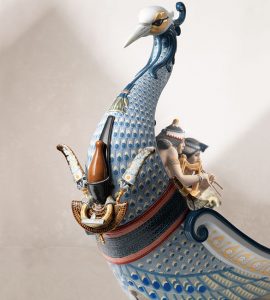They captivate people the world over with their delicate beauty and romanticism. Their simple styles and soft tones have a worldwide appeal. Lladro, a near-six decade old maker of porcelain figurines is a family-owned company operating out of a factory in Valencia, Spain. Miguel Ángel Catalá, Chief Ornamentalist, Lladro tells us more about the creative process behind these historic collectibles.
Each Lladró piece is the result of a meticulous artistic process. Sculptors follow their inspiration but also carry out a thorough process of research and documentation for pieces or collections that reflect other cultures. The highly sought-after figurines hold pride of place in the homes of Lladrophiles the world over and are also found in the permanent collections of several museums.
Within the Lladró team of artists, ornamentalists play a key role in the process of creating a piece, adding superiority and brilliance to it. Their work runs in parallel to that of the sculptor. Right from the stage of modelling the initial sketch, ornamentalists undertake all the details and elements of the composition not concerned directly with the treatment of the human figure, but the setting, the scene, the ambience or the era.
The process of how Lladro figurines are created is actually quite fascinating as Miguel explains. A Lladro figurine begins its life as a simple sketch. Once a sketch has been approved, a model is cast in clay by a master sculptor. The model is slightly larger than the finished figure to allow for shrinkage when fired. The sculpture is then examined to make any necessary changes before giving it final approval.

Once approved the model is cut into several pieces to form moulds. The moulds are filled with a secret blend of porcelain that is actually a carefully guarded family secret. Once hardened, they are removed and inspected. The individual pieces are hand polished to ensure a seamless joining. The figurines are then reassembled using liquid porcelain to cement them together.

The next step is the process of hand painting the figurine. Using hand tools and carving techniques, the surface is smoothed down, continuously adding, thinning, engraving or retouching until the forms are well defined. This is done craftsmen who specialize in this process. After the figurine is painted, decorative accents such as parasols, leaves and flowers may be added depending on the particular design. The task of adding these flowers to a figurine is painstaking and time consuming as each leaf and petal must be individually modelled and applied to the sculpture.
The matte figurine is ready to be fired. The figurine is then fired in a kiln. Once removed and cooled, a final check is done to ensure the figurine meets their high standards.
Some of the major pieces that marked a turning point in the team’s work were the carriages made during the 1980s, like Cinderella’s Arrival or XVIIIth Century Coach. As Miguel Ángel points out, “these pieces sum up all we are able to do. And it was when we realized that our contribution consists in more than just painting borders or trims: it involves recreating a whole period through elements like clothes, vegetation or even the padding of the coach seats.”






